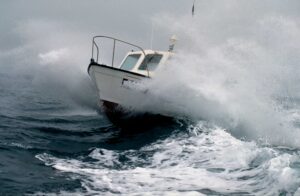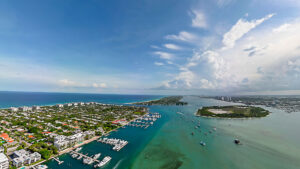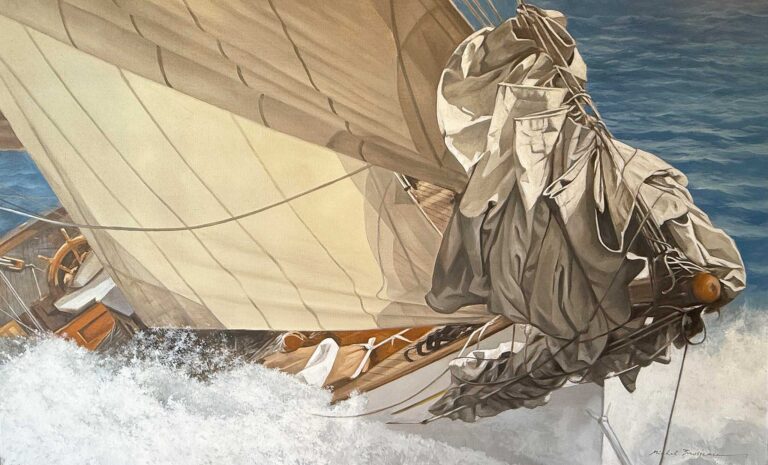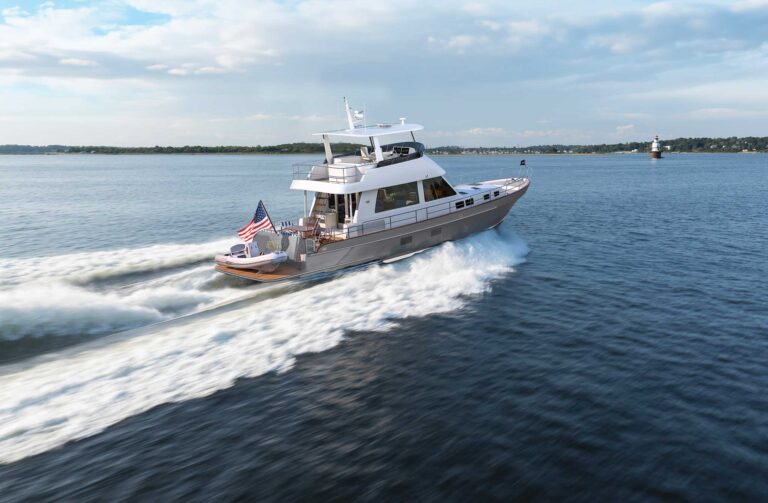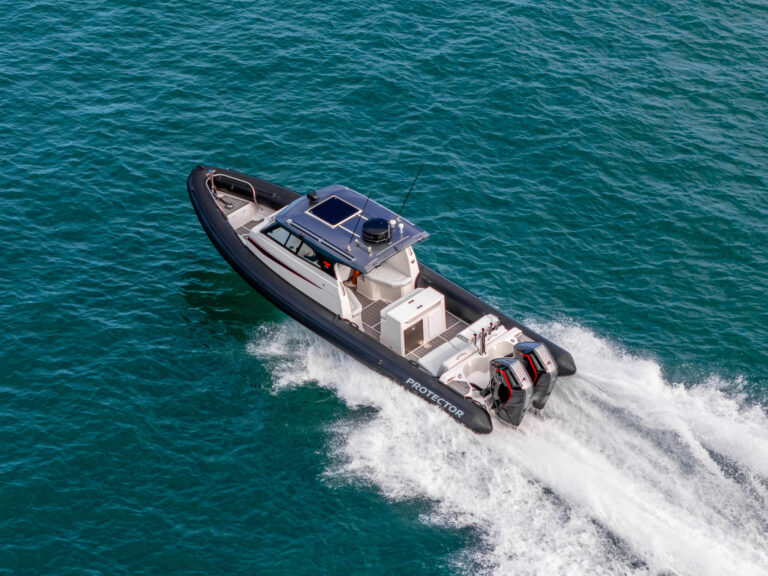Luring Bob Grieser into the fine sport of sailing was a great pleasure for me, especially when it changed his life and he went on to exceed all expectations. That former newspaper copy boy is now an international yachting photographer, and sailors everywhere are the better for it because of his dramatic images.

Square Man Bob, as he was known on those outings under sail with me and others more than 40 years ago on Chesapeake Bay, was unusually attentive and interested from the start. He asked all the right questions and caught on quickly. I sensed I had a lifer in the making when he became reluctant to turn the tiller over to a known helm hog.
Based in San Diego for the past 33 years, Grieser travels the world on assignment but often returns to his home waters of the Bay to shoot. One is made aware of his presence by his big-bad-dog bark, which immediately silences any gathering and turns worried heads in his direction.
He was back in Maryland in May to visit his sister, Mary Ann Jordan, and her husband, Ray. Sunburned after a two-week cruise in the Grenadines and Windward Islands aboard a 44.4-foot Robertson and Caine catamaran, he would be sailing Mexico’s Sea of Cortez later in the month on yet another cruising assignment. His wife, Georgia — “she’s better than a wife,” he says — mostly stays home, running Bob Grieser Photography and keeping track of his calendar and travel itinerary.
I see him about once a year but always remember him as that likable teenage copy boy at the Washington Star newspaper, where he learned the art of photography. He’s now heading toward his 68th birthday, and I can only say, my God, where have those decades gone?
Grieser had done a year at the Indianapolis Times as a copy boy before arriving at the Star in 1965. In that era of pounding typewriters, he “ran” copy hot from reporters’ desks to a central news desk for dissemination. His newspaper career was interrupted when he was drafted into the Army for two years during the Vietnam war, and then did a couple of semesters at the University of Tampa and waited tables in Annapolis. But he always returned to the Star, where he was routinely readmitted as a reliable hand at a cherished place where oddball personalities were tolerated and even appreciated.

Always on the lookout for something different, he soon stepped up in status and salary as a lab tech in the photo department’s darkroom, where he developed black-and-white prints for publication on deadline. Grieser came to know all the talented photographers, many of whom were classic “front page” characters. He began going on assignments with the older pros, learning their techniques, and soon began submitting his own freelance shots and getting them published in the paper.
“My professional mentors at the Star were patient and generous with a newcomer like me — Franny and Ranny Routt, Bernie Boston, John Bowden and Tom Hoy, to name a few,” says Grieser. “The Star was like a clubhouse, and it housed some legendary newspapermen. I was promoted to staff photographer in 1978.” The paper folded in 1981.
Grieser’s camera in those days was a Nikon, a present from his father that he still has. He now uses Canon cameras almost exclusively and, of course, has gone digital. “What a relief not to deal with rolls of film and canisters and run out of film at the worst possible moment,” he says.
In the late 1960s, Grieser was drawn to a group of sailing reporters and editors who gathered in a far corner of the newsroom on Monday mornings. “I wondered why they were laughing so heartily at what seemed to be shared experiences — some of them near-disasters, including one member whose sailboat had sunk under him in a squall,” he recalls. “I soon discovered they were ‘members’ of a self-proclaimed Star Navy, recounting their weekend sailing adventures, and I thought it might be fun to be part of that group and go sailing with them.” By 1970, Grieser was crewing aboard Duncan Spencer’s 35-foot Eastern Interclub, Pete and Linda Baker’s Pennant 24 and my 32-foot Viking International One-Design — all wooden boats.
“We call him Square Man because he stands 5 feet, 6 inches and, at his squarest prime, weighed a robust 250 pounds,” wrote Spencer in the now-defunct sailing publication Rags (where I was managing editor). “He has a low center of gravity, great winch-grinding strength, and is agile, graceful and as sure-footed as a mountain goat. He would hang on his critical perch on a windward rail long after most others had become sick or caved in and crawled aft out of the cold spray of the night.”
In the late 1970s, he turned more and more to freelancing on the side, photographing life on the Chesapeake. He bought his first photo boat, an 18-foot Sea Otter, a center console with a bathtub stern. Much of that early work was published in magazines such as Chesapeake Bay, Sail, and Soundings. He also shot many boats under sail and peddled prints to skippers and crewmembers.
After the Star folded, staff reporters began scrambling for work at other papers. Grieser and I landed in Los Angeles — he at the L.A. Times as photo bureau chief of the San Diego edition and me as a feature writer at the L.A. Herald-Examiner. Grieser stayed with the Times until 1999, when he left to shoot yachts full time while also covering major golf tournaments in Southern California.
Grieser is almost recklessly daring when positioning for shots aboard his chase boat, a 23.5-foot RIB with a 115-hp Yamaha. He moves with the best of yachting’s lensmen in other boats in a shared pursuit of stopping the drama of racing sailboats. He stands out in a crowd. Short and squat, his rotund body is topped by a bald, freckled head ringed with untamed ringlets of white hair. His white beard is piratical in nature. His legs are stout pillars, as if specially created for his specific purpose. Even so, he has been swept off his feet but never off the action boats, except for the one time when he backed off the gunwale of a Bay workboat while positioning for a better angle.
Pete Baker, an old friend and Star Navy colleague, recalls a harrowing incident aboard Spencer’s 52-foot Karin en route to Newport, Rhode Island, from Galesville, Maryland. “We were sitting on some bags of sail that were lashed to the foredeck, in 20 knots of wind and not wearing PFDs,” he says. “A beam sea was running. Waves regularly broke away from the bow, showering the foredeck with heavy spray and phosphorescence. We passed the night hours ‘drunken with the moon and an old sailor’s tunes and loud with the breaking backs of graybeards.’ ”
And wham! A rogue sea came aboard, washing them fast toward the leeward rail, where black seas waited to claim them. Baker grabbed Grieser as he slipped over the toe rail while the wave thundered over them and passed on. “We laughed, as seemingly fearless young men will sometimes do,” he says. “But we were scared, and, soaked through, we sheepishly trundled back to the cockpit. It was a baptism of sorts, a dunking that taught us how fragile life can be, especially at sea.”
The Square Man shows no signs of slowing down. When he has spare time, he catalogs thousands of images, which are available in his stock photography library Outside Images (outsideimages.com). He also is compiling his Caribbean work for a coffee-table book.
Hey, Square Man, let’s end this salty yarn with a big bad-dog bark! Duck, here it comes … n
Jack Sherwood is writer at large for Soundings.
July 2014 issue


